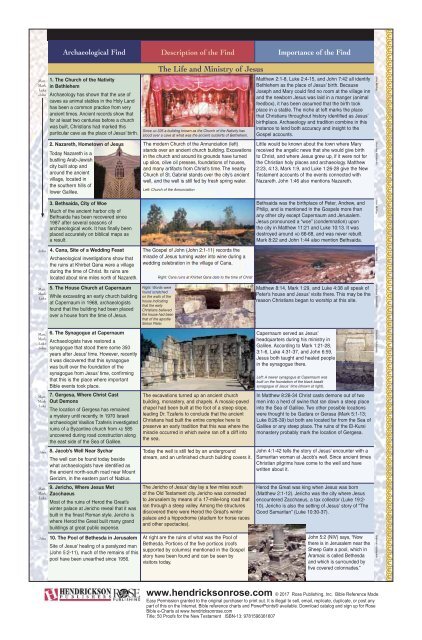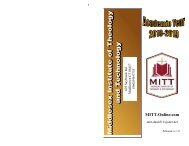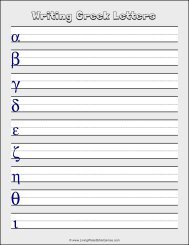50_Proofs_for the Bible
You also want an ePaper? Increase the reach of your titles
YUMPU automatically turns print PDFs into web optimized ePapers that Google loves.
<strong>50</strong><strong>Proofs</strong>NT_B.indd 1<br />
Matt.<br />
Mark<br />
Luke<br />
John<br />
John<br />
Matt.<br />
Mark<br />
Luke<br />
Matt.<br />
Mark<br />
Luke<br />
John<br />
Matt.<br />
Mark<br />
Luke<br />
1. The Church of <strong>the</strong> Nativity<br />
in Bethlehem<br />
Archaeology has shown that <strong>the</strong> use of<br />
caves as animal stables in <strong>the</strong> Holy Land<br />
has been a common practice from very<br />
ancient times. Ancient records show that<br />
<strong>for</strong> at least two centuries be<strong>for</strong>e a church<br />
was built, Christians had marked this<br />
particular cave as <strong>the</strong> place of Jesus’ birth.<br />
2. Nazareth, Hometown of Jesus<br />
Today Nazareth is a<br />
bustling Arab-Jewish<br />
city built atop and<br />
around <strong>the</strong> ancient<br />
village, located in<br />
<strong>the</strong> sou<strong>the</strong>rn hills of<br />
lower Galilee.<br />
3. Bethsaida, City of Woe<br />
Much of <strong>the</strong> ancient harbor city of<br />
Bethsaida has been recovered since<br />
1987 after several seasons of<br />
archaeological work. It has finally been<br />
placed accurately on biblical maps as<br />
a result.<br />
7. Gergesa, Where Christ Cast<br />
Out Demons<br />
The location of Gergesa has remained<br />
a mystery until recently. In 1970 Israeli<br />
archaeologist Vasilios Tzaferis investigated<br />
ruins of a Byzantine church from AD 585<br />
uncovered during road construction along<br />
<strong>the</strong> east side of <strong>the</strong> Sea of Galilee.<br />
John 8. Jacob’s Well Near Sychar<br />
The well can be found today beside<br />
what archaeologists have identified as<br />
<strong>the</strong> ancient north-south road near Mount<br />
Gerizim, in <strong>the</strong> eastern part of Nablus.<br />
Matt.<br />
Mark<br />
Luke<br />
Archaeological Find Description of <strong>the</strong> Find Importance of <strong>the</strong> Find<br />
4. Cana, Site of a Wedding Feast<br />
Archaeological investigations show that<br />
<strong>the</strong> ruins at Khirbet Qana were a village<br />
during <strong>the</strong> time of Christ. Its ruins are<br />
located about nine miles north of Nazareth.<br />
5. The House Church at Capernaum<br />
While excavating an early church building<br />
at Capernaum in 1968, archaeologists<br />
found that <strong>the</strong> building had been placed<br />
over a house from <strong>the</strong> time of Jesus.<br />
6. The Synagogue at Capernaum<br />
Archaeologists have restored a<br />
synagogue that stood <strong>the</strong>re some 3<strong>50</strong><br />
years after Jesus’ time. However, recently<br />
it was discovered that this synagogue<br />
was built over <strong>the</strong> foundation of <strong>the</strong><br />
synagogue from Jesus’ time, confirming<br />
that this is <strong>the</strong> place where important<br />
<strong>Bible</strong> events took place.<br />
9. Jericho, Where Jesus Met<br />
Zacchaeus<br />
Most of <strong>the</strong> ruins of Herod <strong>the</strong> Great’s<br />
winter palace at Jericho reveal that it was<br />
built in <strong>the</strong> finest Roman style. Jericho is<br />
where Herod <strong>the</strong> Great built many grand<br />
buildings at great public expense.<br />
John 10. The Pool of Be<strong>the</strong>sda in Jerusalem<br />
Site of Jesus’ healing of a paralyzed man<br />
(John 5:2-11), much of <strong>the</strong> remains of this<br />
pool have been unear<strong>the</strong>d since 1956.<br />
Since AD 326 a building known as <strong>the</strong> Church of <strong>the</strong> Nativity has<br />
stood over a cave at what was <strong>the</strong> ancient outskirts of Bethlehem.<br />
The modern Church of <strong>the</strong> Annunciation (left)<br />
stands over an ancient church building. Excavations<br />
in <strong>the</strong> church and around its grounds have turned<br />
up silos, olive oil presses, foundations of houses,<br />
and many artifacts from Christ’s time. The nearby<br />
Church of St. Gabriel stands over <strong>the</strong> city’s ancient<br />
well, and <strong>the</strong> well is still fed by fresh spring water.<br />
Left: Church of <strong>the</strong> Annunciation<br />
The Gospel of John (John 2:1-11) records <strong>the</strong><br />
miracle of Jesus turning water into wine during a<br />
wedding celebration in <strong>the</strong> village of Cana.<br />
Right: Words were<br />
found scratched<br />
on <strong>the</strong> walls of <strong>the</strong><br />
house indicating<br />
that <strong>the</strong> early<br />
Christians believed<br />
<strong>the</strong> house had been<br />
that of <strong>the</strong> apostle<br />
Simon Peter.<br />
The Life and Ministry of Jesus<br />
Right: Cana ruins at Khirbet Qana date to <strong>the</strong> time of Christ<br />
The excavations turned up an ancient church<br />
building, monastery, and chapels. A mosaic-paved<br />
chapel had been built at <strong>the</strong> foot of a steep slope,<br />
leading Dr. Tzaferis to conclude that <strong>the</strong> ancient<br />
Christians had built <strong>the</strong> entire complex here to<br />
preserve an early tradition that this was where <strong>the</strong><br />
miracle occurred in which swine ran off a cliff into<br />
<strong>the</strong> sea.<br />
Today <strong>the</strong> well is still fed by an underground<br />
stream, and an unfinished church building covers it.<br />
The Jericho of Jesus' day lay a few miles south<br />
of <strong>the</strong> Old Testament city. Jericho was connected<br />
to Jerusalem by means of a 17-mile-long road that<br />
ran through a steep valley. Among <strong>the</strong> structures<br />
discovered <strong>the</strong>re were Herod <strong>the</strong> Great's winter<br />
palace and a hippodrome (stadium <strong>for</strong> horse races<br />
and o<strong>the</strong>r spectacles).<br />
At right are <strong>the</strong> ruins of what was <strong>the</strong> Pool of<br />
Be<strong>the</strong>sda. Portions of <strong>the</strong> five porticos (roofs<br />
supported by columns) mentioned in <strong>the</strong> Gospel<br />
story have been found and can be seen by<br />
visitors today.<br />
Mat<strong>the</strong>w 2:1-8, Luke 2:4-15, and John 7:42 all identify<br />
Bethlehem as <strong>the</strong> place of Jesus’ birth. Because<br />
Joseph and Mary could find no room at <strong>the</strong> village inn<br />
and <strong>the</strong> newborn Jesus was laid in a manger (animal<br />
feedbox), it has been assumed that <strong>the</strong> birth took<br />
place in a stable. The niche at left marks <strong>the</strong> place<br />
that Christians throughout history identified as Jesus’<br />
birthplace. Archaeology and tradition combine in this<br />
instance to lend both accuracy and insight to <strong>the</strong><br />
Gospel accounts.<br />
Little would be known about <strong>the</strong> town where Mary<br />
received <strong>the</strong> angelic news that she would give birth<br />
to Christ, and where Jesus grew up, if it were not <strong>for</strong><br />
<strong>the</strong> Christian holy places and archaeology. Mat<strong>the</strong>w<br />
2:23, 4:13, Mark 1:9, and Luke 1:26-28 give <strong>the</strong> New<br />
Testament accounts of <strong>the</strong> events connected with<br />
Nazareth. John 1:46 also mentions Nazareth.<br />
Bethsaida was <strong>the</strong> birthplace of Peter, Andrew, and<br />
Philip, and is mentioned in <strong>the</strong> Gospels more than<br />
any o<strong>the</strong>r city except Capernaum and Jerusalem.<br />
Jesus pronounced a “woe” (condemnation) upon<br />
<strong>the</strong> city in Mat<strong>the</strong>w 11:21 and Luke 10:13. It was<br />
destroyed around AD 66-68, and was never rebuilt.<br />
Mark 8:22 and John 1:44 also mention Bethsaida.<br />
Mat<strong>the</strong>w 8:14, Mark 1:29, and Luke 4:38 all speak of<br />
Peter’s house and Jesus’ visits <strong>the</strong>re. This may be <strong>the</strong><br />
reason Christians began to worship at this site.<br />
Capernaum served as Jesus’<br />
headquarters during his ministry in<br />
Galilee. According to Mark 1:21-28,<br />
3:1-6, Luke 4:31-37, and John 6:59,<br />
Jesus both taught and healed people<br />
in <strong>the</strong> synagogue <strong>the</strong>re.<br />
Left: A newer synagogue at Capernaum was<br />
built on <strong>the</strong> foundation of <strong>the</strong> black basalt<br />
synagogue of Jesus’ time (shown at right).<br />
In Mat<strong>the</strong>w 8:28-34 Christ casts demons out of two<br />
men into a herd of swine that ran down a steep place<br />
into <strong>the</strong> Sea of Galilee. Two o<strong>the</strong>r possible locations<br />
were thought to be Gadara or Gerasa (Mark 5:1-13;<br />
Luke 8:26-39) but both are located far from <strong>the</strong> Sea of<br />
Galilee or any steep place. The ruins of <strong>the</strong> El-Kursi<br />
monastery probably mark <strong>the</strong> location of Gergesa.<br />
John 4:1-42 tells <strong>the</strong> story of Jesus’ encounter with a<br />
Samaritan woman at Jacob’s well. Since ancient times<br />
Christian pilgrims have come to <strong>the</strong> well and have<br />
written about it.<br />
Herod <strong>the</strong> Great was king when Jesus was born<br />
(Mat<strong>the</strong>w 2:1-12). Jericho was <strong>the</strong> city where Jesus<br />
encountered Zacchaeus, a tax collector (Luke 19:2-<br />
10). Jericho is also <strong>the</strong> setting of Jesus' story of “The<br />
Good Samaritan” (Luke 10:30-37).<br />
John 5:2 (NIV) says, “Now<br />
<strong>the</strong>re is in Jerusalem near <strong>the</strong><br />
Sheep Gate a pool, which in<br />
Aramaic is called Be<strong>the</strong>sda<br />
and which is surrounded by<br />
five covered colonnades.”<br />
John McRay Gretchen Goldsmith<br />
John McRay John McRay<br />
Gretchen Goldsmith<br />
Gretchen Goldsmith<br />
Gretchen Goldsmith<br />
www.hendricksonrose.com © 2017 Rose Publishing, Inc. <strong>Bible</strong> Reference Made<br />
Easy Permission granted to <strong>the</strong> original purchaser to print out. It is illegal to sell, email, replicate, duplicate, or post any<br />
part of this on <strong>the</strong> Internet. <strong>Bible</strong> reference charts and PowerPoints® available. Download catalog and sign up <strong>for</strong> Rose<br />
<strong>Bible</strong> e-Charts at www.hendricksonrose.com<br />
Title: <strong>50</strong> <strong>Proofs</strong> <strong>for</strong> <strong>the</strong> New Testament ISBN-13: 9781596361607




